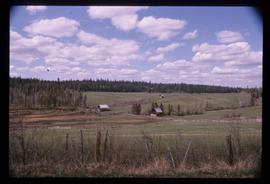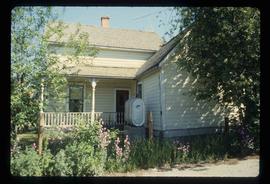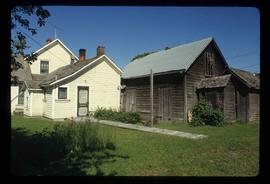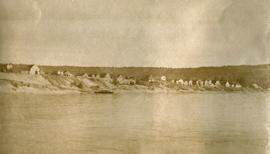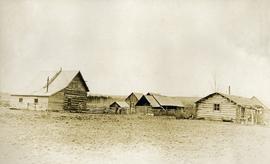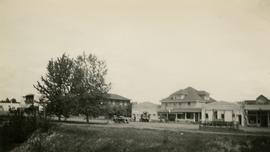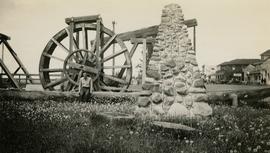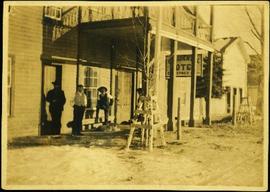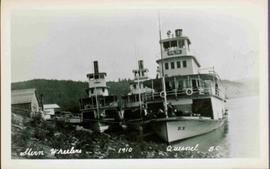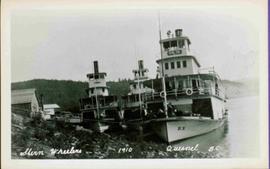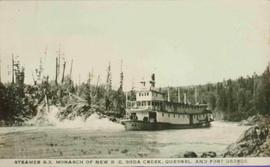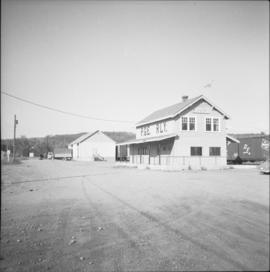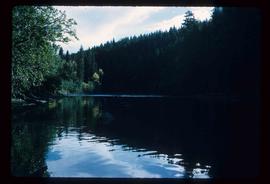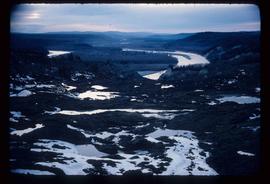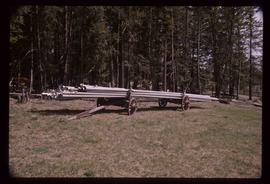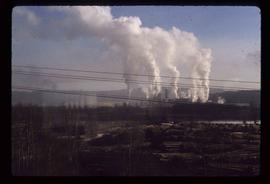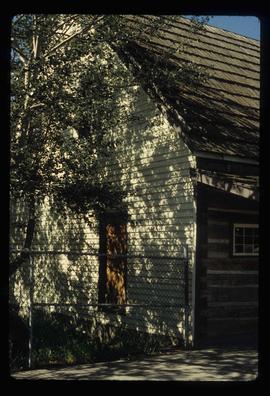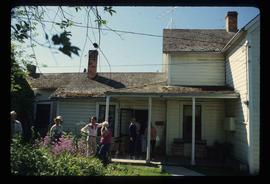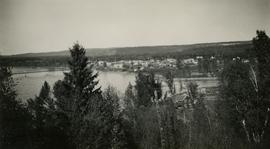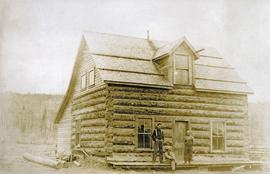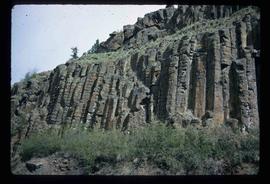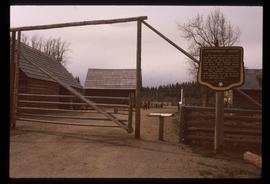Image depicts a view of the property at 153 Mile House, near Quesnel, B.C.
Image depicts the Bohanon House in Quesnel, B.C.
Image depicts the Bohanon House in Quesnel, B.C.
Photograph depicts a long row of buildings bordering a river. A scow is anchored near the river bank.
Photograph depicts a man standing on the deck of a ferry boat. A long row of building line the riverbank in the background.
Photograph depicts a cluster of log buildings with fences and corrals. A field in the foreground, trees and low hills in the distance. On the road from Quesnell to Fraser Lake 1911.
In 1936, Gordon Young Wyness was employed by Philip M. Monckton, a B.C. Land Surveyor. Between June 5 and October 8, Wyness joined Monckton and a group of others on a land survey expedition in northwestern BC. The survey crew travelled to various locations in the area including Telkwa, Hazelton, Burns Lake, Francoise Lake, Vanderhoof, Prince George, Quesnel, Lytton, and Hope. Wyness documented their journey in this photograph album. Based on the photographs, it appears that the crew led by Philip Monckton consisted of Jack Lee and Gordon Wyness; Mrs. Lavender Monckton (nee O'Hara) also accompanied the group.
In addition to the 50 photographs included in the album, this collection also includes five additional unique photographs that accompanied the album.
Sans titrePhotograph depicts a view of Front Street and Quesnel Hotel from Fraser River Bridge in Quesnel. Visible buildings include the Quesnel Hotel Cafe, the Quesnel Hotel, and John A. Fraser & Co. Ltd.
Photograph depicts Gordon Wyness sitting on a historic boat, which he described as built ca. 1860 and could carry "7 Indians" and 5000 lbs of freight up the river. Located nearby is a telegraph cairn erected to commemorate the Collins Overland Telegraph lines that began in Quesnel in 1865. Until 1907, Quesnel was the terminus for the telegraph line. Behind Wyness is a replica of a Cornish water wheel that was originally located at Williams Creek in Barkerville. This location is now called Ceal Tingley Memorial Park-Heritage Corner and is located along Front Street in Quesnel, near the Fraser River Bridge. The cairn and water wheel still stand in this location, however the boat was removed around 1941.
According to additional information from Quesnel & District Museum & Archives, Wyness may have been provided with inaccurate information about the canoe depicted. The canoe believed to have been located at that spot was actually created in 1905 to pack out the Grand Trunk Preliminary Survey Team, which was led by J.M. Rolston.
File consists of 1 audiocassette of interview by Bob Harkins with rancher, author Harold 'Dude' Lavington who discusses the publication of his books and ranching life in Quesnel area.
Sans titreFile consists of 1 audiocassette of interview by Gil McCall of CIBC FM Radio with rancher and author Harold Dude Lavington who discusses ranching life and the publication of his books.
File consists of 1 audiocassette of interviews possibly by Bridget Moran with Arnold Davis and Claude Foot.
Sans titrePhotograph depicts four men standing under balcony of hotel near other buildings on street. Trees line the street, with protective structures built around their trunks. It is speculated that one of these men may be Mr. A. K. Bourchier. Handwritten annotation on recto of photograph: "As you were".
Photographs within this file pertain to modes of transportation and transportation routes (including construction, surveying and traveling).
Photograph features three sternwheelers tied to river bank. Buildings visible on far left, hills on shore visible in background.
Printed annotation on recto reads: “Stern Wheelers 1910 Quesnel B.C.” Handwritten annotation on verso in pencil reads: “BX, B.C. Express, Charlotte”
3 Sternwheelers tied to a river bank. Printed annotation on recto reads: “Stern Wheelers 1910 Quesnel B.C.” Handwritten annotation on verso in pencil reads: “BX, B.C. Express, Charlotte”
Stern wheeler in river. Printed annotation on recto reads: “Steamer B.X. Monarch of New B.C. Soda Creek, Quesnel and Fort George”
Photograph taken at the Pacific Great Eastern depot in Quesnel.
Image depicts the Fraser River from Highway 97 near Quesnel, B.C.
Image depicts the location of a slump type of landslide at Moose Heights, north of Quesnel, B.C.
Image depicts a pile of irrigation pipes on a dairy farm somewhere near Quesnel, B.C.
Image depicts a sawmill somewhere in Quesnel, B.C.
Image depicts the Hudson Bay store in Quesnel, B.C. It was built in 1859.
Image depicts numerous unknown individuals at the Bohanon House in Quesnel, B.C.
Photograph depicts a view of the town of Quesnel from a southeast hill. Fraser River and the Fraser River Bridge are visible at left, the Quesnel River at right.
Photograph depicts three men standing and sitting on a porch deck in front of a log house, trees in the background.
File contains slides depicting landforms at various locations.
Image depicts a basalt landform somewhere in or near Quesnel, B.C.
Image depicts the Cottonwood House Historic Site along Barkerville Highway, east of Quesnel, B.C. A sign posted by the fence reads: "For over half a century the Boyd family operated this haven for man and beast. Here weary travellers found lodging, food, and drink. Here fresh horses were hitched to stage-coaches and miners bought supplies. This historic road-house, built in 1864, stood as an oasis of civilization on the frontier of a rich new land."
